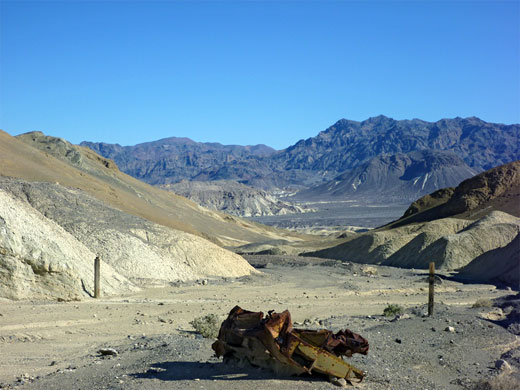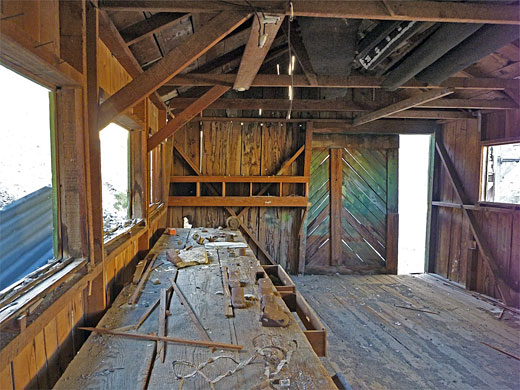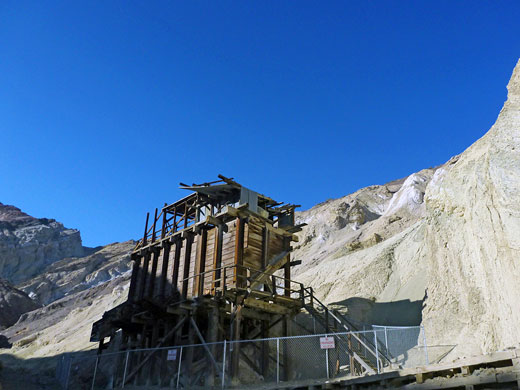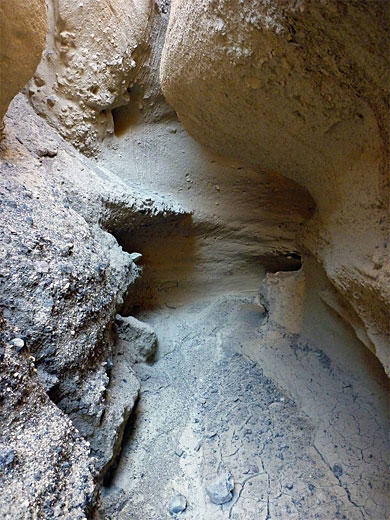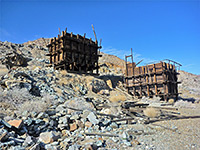Corkscrew Canyon, Death Valley National Park
California > Death Valley National Park > The South > Corkscrew Canyon
Corkscrew Canyon
Shallow, branched drainage through undulating, yellowish badlands. One fork forms a pretty section of narrows, while another contains an old mine site including a well preserved wooden structure used for ore processing
Length: 4.3 miles, round trip, to the mine and the narrows
Elevation change: 800 feet
Difficulty: Easy
Type: One way
Usage: Low
Season: Fall, winter, spring
Trailhead: Beside CA 190
Rating (1-5): ★★★★★
Elevation change: 800 feet
Difficulty: Easy
Type: One way
Usage: Low
Season: Fall, winter, spring
Trailhead: Beside CA 190
Rating (1-5): ★★★★★
Corkscrew Canyon is a minor drainage through the foothills of the Black Mountains, a few miles from Zabriskie Point, alongside highway 190 towards the east edge of Death Valley National Park, winding through the same stark, brightly colored, undulating hills as are found around nearby Twenty Mule Team Canyon.
There are two reasons to visit; the canyon contains an interesting old mine site with relics including an ore processing plant, cabin, adits and short sections of rail track, while a separate branch of the drainage forms half a mile of narrow passageways, which are shallow but quite pretty, dark and enclosed in some sections. The ravine seems very little known but is easily accessed via the disused track to the mine, starting from Hwy 190 - a fairly level hike of about 1.5 miles, and both the mine and the narrows can be explored in about two hours.
Map of Death Valley National Park and surroundings.
24 views of Corkscrew Canyon.
A suitable parking place is beside Hwy 190 where it crosses the wide dry wash leading to the canyon, which is bordered by low, yellow hills to the west and whitish mounds to the east - a location 1.1 miles east of the east end of Twenty Mule Team Canyon Road. An old wooden fence crosses the wash, parallel to the highway, with a closed gate in the middle and a faded 'Restricted Area' notice, seemingly to indicate that the dirt track beyond is closed to vehicles, though it provides an easy hiking route.
The track follows the wash southwards, veering to the west side, running along the edge of the yellowish hills until they fade away, after which it crosses a wide, flat area, heading towards the rounded summits at the edge of the Black Mountains. There are good views now in all directions - across to the Hole-in-the-Wall region on the far side of Hwy 190, west towards Twenty Mule Team Canyon and south to the multicolored slopes ahead. The old road approaches the foothills, passing a few pieces of debris from the mine, then enters a shallow valley, which rounds one bend, where it is crossed by a fence, and then a second, where the ore processing plant from the mine first comes into view. The upwards slope becomes somewhat steeper, as the drainage curves through a few tighter bends and then reaches the mine site.
A wooden shed sits on one side of the ravine, containing a bench and a few artifacts, while the main structure, known as an ore bin, is built a little way up the opposite side, seemingly complete, and well preserved, linked to an adit further up the hillside by a short section of elevated rail line. The tunnel is of course securely sealed, by a circular iron gate, as is a similar passage just beyond. The ore bin is enclosed by a metal fence bearing several NPS warning notices, which inevitably spoils the appearance somewhat yet the site is still evocative and photogenic, especially viewed from upstream, looking down the canyon across to the distant mountains of the Funeral Range. The timbers are nicely aged, and the ironwork rusty though both still appear sturdy, and the structure looks set to remain intact for many decades. Corkscrew Mine operated briefly in the 1950s producing colemanite, a white, crystalline borate mineral that was used as a component of airborne retardants to fight forest fires; activity was short-lived as the material was found to cause soil to become sterile.
The slot canyon is formed by a tributary ravine on the east side just below the mine, recognizable by a small pinnacle just south of the junction. The stony creek bed is similar in size to that of the main canyon, suggesting that the drainage is significant, carrying a fair amount of water on the rare occasions that a stream flows. The passageways are very twisty and soon narrow, forming some dark and enclosed sections, in which the only obstacles are a few small dryfalls and two chokestones that have created natural bridges. Most of the canyon walls are composed of soft, pebbly conglomerate but the narrowest parts are through harder, more homogenous sandstone. The enclosing cliffs have nice textures, and passages curve through graceful, rounded corners. The canyon opens out for a quarter of a mile, winding towards higher slopes, which have more varied colors including deep red and grey-green - the slot is all through rather dull, yellowish/brown hills. Doubtless there are other short slots hereabouts, as the hillsides are crossed by many steep, branched ravines.
There are two reasons to visit; the canyon contains an interesting old mine site with relics including an ore processing plant, cabin, adits and short sections of rail track, while a separate branch of the drainage forms half a mile of narrow passageways, which are shallow but quite pretty, dark and enclosed in some sections. The ravine seems very little known but is easily accessed via the disused track to the mine, starting from Hwy 190 - a fairly level hike of about 1.5 miles, and both the mine and the narrows can be explored in about two hours.
Location
Map of Death Valley National Park and surroundings.
Photographs
24 views of Corkscrew Canyon.
Location
A suitable parking place is beside Hwy 190 where it crosses the wide dry wash leading to the canyon, which is bordered by low, yellow hills to the west and whitish mounds to the east - a location 1.1 miles east of the east end of Twenty Mule Team Canyon Road. An old wooden fence crosses the wash, parallel to the highway, with a closed gate in the middle and a faded 'Restricted Area' notice, seemingly to indicate that the dirt track beyond is closed to vehicles, though it provides an easy hiking route.
Trail to the Mine
The track follows the wash southwards, veering to the west side, running along the edge of the yellowish hills until they fade away, after which it crosses a wide, flat area, heading towards the rounded summits at the edge of the Black Mountains. There are good views now in all directions - across to the Hole-in-the-Wall region on the far side of Hwy 190, west towards Twenty Mule Team Canyon and south to the multicolored slopes ahead. The old road approaches the foothills, passing a few pieces of debris from the mine, then enters a shallow valley, which rounds one bend, where it is crossed by a fence, and then a second, where the ore processing plant from the mine first comes into view. The upwards slope becomes somewhat steeper, as the drainage curves through a few tighter bends and then reaches the mine site.
Corkscrew Mine
A wooden shed sits on one side of the ravine, containing a bench and a few artifacts, while the main structure, known as an ore bin, is built a little way up the opposite side, seemingly complete, and well preserved, linked to an adit further up the hillside by a short section of elevated rail line. The tunnel is of course securely sealed, by a circular iron gate, as is a similar passage just beyond. The ore bin is enclosed by a metal fence bearing several NPS warning notices, which inevitably spoils the appearance somewhat yet the site is still evocative and photogenic, especially viewed from upstream, looking down the canyon across to the distant mountains of the Funeral Range. The timbers are nicely aged, and the ironwork rusty though both still appear sturdy, and the structure looks set to remain intact for many decades. Corkscrew Mine operated briefly in the 1950s producing colemanite, a white, crystalline borate mineral that was used as a component of airborne retardants to fight forest fires; activity was short-lived as the material was found to cause soil to become sterile.
Slot Canyon
The slot canyon is formed by a tributary ravine on the east side just below the mine, recognizable by a small pinnacle just south of the junction. The stony creek bed is similar in size to that of the main canyon, suggesting that the drainage is significant, carrying a fair amount of water on the rare occasions that a stream flows. The passageways are very twisty and soon narrow, forming some dark and enclosed sections, in which the only obstacles are a few small dryfalls and two chokestones that have created natural bridges. Most of the canyon walls are composed of soft, pebbly conglomerate but the narrowest parts are through harder, more homogenous sandstone. The enclosing cliffs have nice textures, and passages curve through graceful, rounded corners. The canyon opens out for a quarter of a mile, winding towards higher slopes, which have more varied colors including deep red and grey-green - the slot is all through rather dull, yellowish/brown hills. Doubtless there are other short slots hereabouts, as the hillsides are crossed by many steep, branched ravines.

Disused road to the Corkscrew mine site, surrounded by badlands in the foothills of the Black Mountains
Corkscrew Canyon - Similar Hikes
All Contents © Copyright The American Southwest | Comments and Questions | Contribute | Affiliate Marketing Disclosure | Site Map




